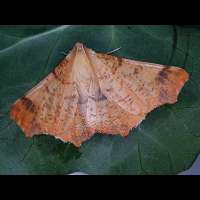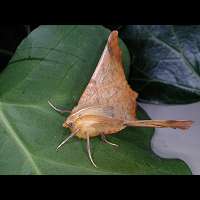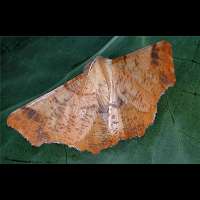Large Thorn (Ennomos autumnaria)
As the name implies the Large Thorn is our largest Thorn. At least the females are. Reaching a wingspan of some 55 to 64 mm they are truely enormous and have no similar species to confuse them with. The males on the other hand are much smaller and usually reach a wingspan of some 48 to 54 mm. This makes them just as big as the females of various other Thorn species. Identifying them is easy though, for they are the only Thorns with darkened spots in the corner of the wings. In both genders there is some variation in the number of dark speckles, but overall this is not a variable species at all. Besides the Large Thorn and the Canary-shouldered Thorn there are various other yellowish Thorns in Britain, but most are very local or rare.
The caterpillar of the Large Thorn is similar to other Thorn Geometer Worms, but usually has a brighter colour. It too pretends to be a twig. On the body it has three, rather small bumps only. Like the Canary-shouldered Thorn's larva the caterpillar of the Large Thorn is thin, but long and tapered towards the head, which is brown. It may be well over 5 cm long. The eggs are being laid in September and October and overwinter. Only in May of the next year do they hatch. The caterpillar lives on a large number of trees, including birch, oak, alder, hazel and sycamore. It feeds at night and sits motionless through the day trusting on its camouflage to fool predators. In August it drops to the ground and pupates in a cocoon in leaf litter or under mosses.
The Large Thorn is single brooded and on the wing from July to October. It flies during the hours of darkness and is very difficult to find during daytime. Luckily it is quite easily attracted to light, and that is your best chance of seeing one. It is a local species in South and Central England, probably absent from Wales and certainly absent from Scotland and Ireland, except for a very few records. Common on the continent, but not a northern species, being absent from most of Scandinavia.
As the name implies the Large Thorn is our largest Thorn. At least the females are. Reaching a wingspan of some 55 to 64 mm they are truely enormous and have no similar species to confuse them with. The males on the other hand are much smaller and usually reach a wingspan of some 48 to 54 mm. This makes them just as big as the females of various other Thorn species. Identifying them is easy though, for they are the only Thorns with darkened spots in the corner of the wings. In both genders there is some variation in the number of dark speckles, but overall this is not a variable species at all. Besides the Large Thorn and the Canary-shouldered Thorn there are various other yellowish Thorns in Britain, but most are very local or rare.
The caterpillar of the Large Thorn is similar to other Thorn Geometer Worms, but usually has a brighter colour. It too pretends to be a twig. On the body it has three, rather small bumps only. Like the Canary-shouldered Thorn's larva the caterpillar of the Large Thorn is thin, but long and tapered towards the head, which is brown. It may be well over 5 cm long. The eggs are being laid in September and October and overwinter. Only in May of the next year do they hatch. The caterpillar lives on a large number of trees, including birch, oak, alder, hazel and sycamore. It feeds at night and sits motionless through the day trusting on its camouflage to fool predators. In August it drops to the ground and pupates in a cocoon in leaf litter or under mosses.
The Large Thorn is single brooded and on the wing from July to October. It flies during the hours of darkness and is very difficult to find during daytime. Luckily it is quite easily attracted to light, and that is your best chance of seeing one. It is a local species in South and Central England, probably absent from Wales and certainly absent from Scotland and Ireland, except for a very few records. Common on the continent, but not a northern species, being absent from most of Scandinavia.







